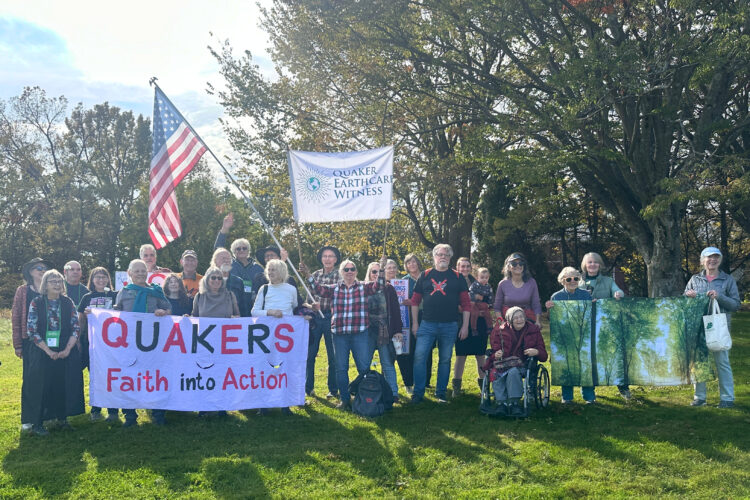A Blueprint for Climate Action

By Paul Klinkman
Friends are encouraged to expand their carbon handprint. Increasing Friends’ involvement can have considerably more impact on the world’s climate than if they simply shrink their carbon footprint. I see Friends acting in four somewhat distinct directions:
- Personal and corporate witness: Abolitionists wouldn’t own slaves and wouldn’t buy slave goods. Moreover, some Friends illegally smuggled contraband slaves to Canada. Climate abolitionists are already organizing vigils, civil disobedience actions and boycotts.
- Political activity: Friends were in the forefront of getting women the right to vote. Bayard Rustin of 15th Street Meeting was the lead organizer of the 1963 March on Washington. Other Friends have been involved with the Bernie Sanders campaign. The FCNL will focus on lobbying. Climate organizations need to formulate a set of Sullivan Principles for climate change, applicable to every corporation and to every nation. No fossil fuel company should have a right to destroy the Earth’s climate without paying for the worldwide damage that its product causes.
- Disaster relief: Friends fed Europe after two world wars. The AFSC’s Penn Craft community was one early model for Habitat for Humanity. Should Friends design a quick response for the expected F-5 tornadoes and for superstorm hurricanes?
- Practical innovation: Friends have been on the forefront of new technology development and of innovative public policy for 300 years. For example, the first railroad locomotive was assembled in Coalbrookdale in England. As a solar inventor, I call for the development of certain specific solar breakthroughs. Once they are successfully implemented, these inventions will essentially abolish the fossil fuel industry worldwide:
- Buildings should heat themselves. Heat is one third of fossil fuel use. A single heat storage system can handle both winter heat and hot water preheating.
- Buildings should use concentrated daylighting. In particular, we’d be happier if we had midwinter solar greenhouses available in the Frost Belt. We equally need affordable algae greenhouses for displacing the last known uses of fossil fuels.
- Currently, photovoltaic power can only cover 1/3 of all electricity use on the East Coast. Solar heat storage systems or better power storage systems could cover most of the other 2/3 of our electric generation needs. Electricity is one third of fossil fuel use.
- Mass transit hasn’t changed all that much since the Quaker Darby family invented most of it around 1800. If we had an above-grade automated transit system based loosely on our current elevator technology, our lifetime transit costs would plummet by a factor of ten versus our current urban freeway system. Transit is one third of fossil fuel use.
- An enormous Arctic methane release may soon have many times the climate impact of all of humankind’s greenhouse gas releases combined. Human civilization will want to inhibit such a methane release. We desire to restore the Arctic Ocean’s ice pack, but at the same time we don’t want to disturb the ocean’s delicate under-ice ecology. In my opinion the main problem with geo-engineering is nothing more than the press barking up the wrong tree, and that problem might be cured.
- Possibly the worst long-range effect of climate change will be a mass species extinction. However, we can save individual species from extinction. Our forefathers saved the bison, the bald eagle, the California condor and the blue whale.
We need an economically sustainable climate invention and product rollout program. If a gigantic forest fire threatens a city, and if the mayor expects some anonymous firefighters to show up and work for free to protect the city’s expensive homes, that mayor will probably wish in retrospect that she had hired the firefighters. Well, humanity is threatened by climate change and inventors can significantly change the threat of climate change. If people actually expect an army of anonymous inventors to save everything that they value, working for free, without paying the inventors, then such people shall in time have occasion for regret.
I ask Friends to construct their own workable climate R&D organization. We shall not imagine that Congress will stand tall anytime soon, nor that gigantic corporations will stand tall. So, I ask that Friends themselves stand nonviolently tall, that they be patterns, be examples, and that they prepare to take on leadership roles in a renewable energy revolution. We need inventors. We also need engineers who can dispassionately sort through renewable energy ideas from everywhere, looking for the most meritorious ideas and improvements.
—————————
Paul Klinkman has presented several times at Friends General Conference in the QEW Earth Center. The opinions expressed here are the author’s and do not necessarily represent QEW.

